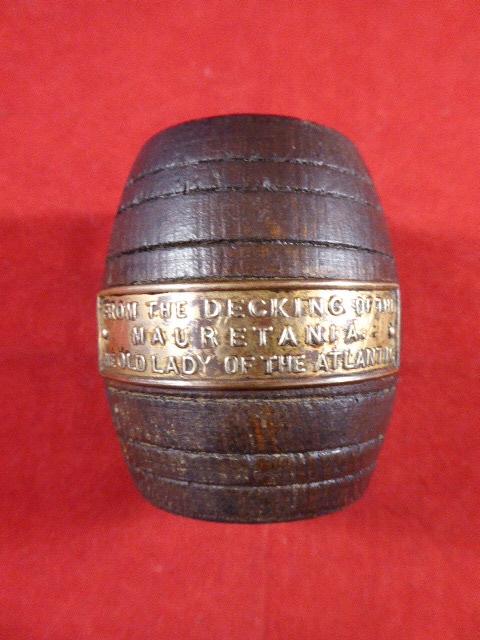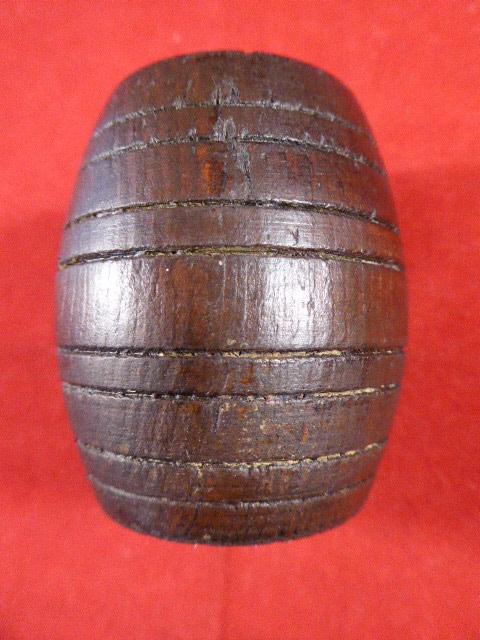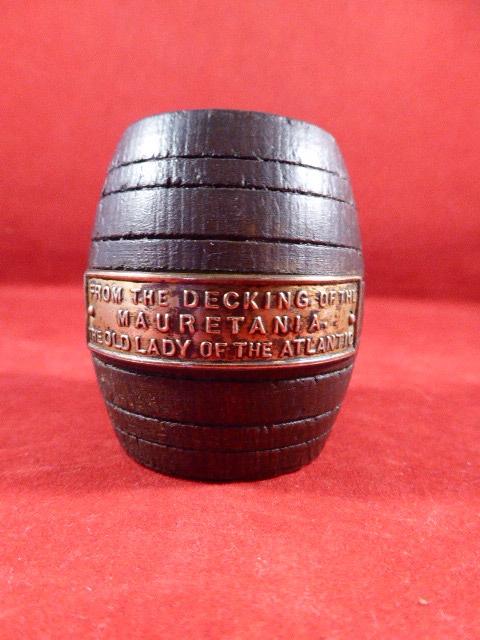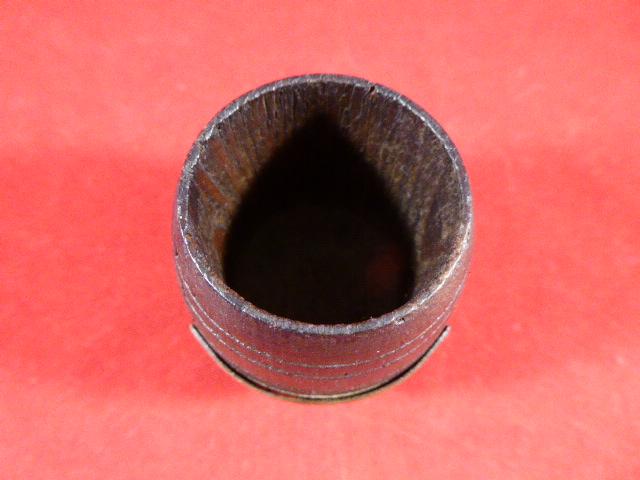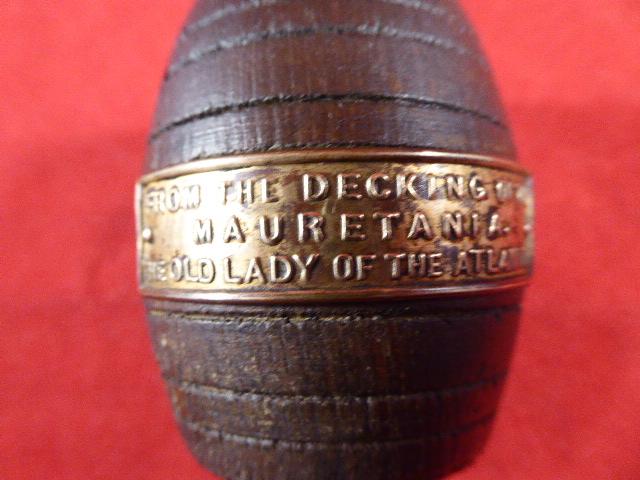Wooden Barrel Match Holder made from the Decking of R.M.S. MAURETANIA
Here on offer is a genuine piece of the wooden decking from the:
R.M.S. MAURETANIA
made into a ribbed barrel shaped match holder.
The beautifully made barrel measures 4.5cm (1.75“) diameter by 5.5cm (2.2”) high.
It has a quality brass plaque pinned to the front, which reads:
FROM THE DECKING OF THE
MAURETANIA
THE OLD LADY OF THE ATLANTIC
Some history relating to this great ship follows:
The ocean liner, Mauretania left Liverpool on her maiden voyage on 16 November 1907 under the command of her first captain, John Pritchard and later that month captured the record for the fastest eastbound crossing of the Atlantic with an average speed of 23.69 knots (43.87 km/h). In September 1909, the Mauretania captured the Blue Riband for the fastest westbound crossing—a record that was to stand for more than two decades. In December 1910 Mauretania broke loose from her moorings while in the River Mersey and sustained damage that caused the cancellation of her special speedy Christmas voyage to New York. In a quick change of events Cunard rescheduled Mauretania's voyage for Lusitania under the command of captain James Charles which had just returned from New York. Lusitania herself completed Christmas crossings for her sister, carrying revellers back to New York. In 1912 both King George and Queen Mary were given a special tour of Mauretania, then Britain's fastest merchant vessel, adding further distinction to the ship's reputation. On 26 January 1914, while Mauretania was in the middle of annual refit in Liverpool, four men were killed and six injured when a gas cylinder exploded while they were working on one of her steam turbines. The damage was minimal and she returned to service two months later.
World War I
Shortly after Great Britain declared war on Germany on 4 August 1914, Mauretania and Aquitania were requested by the British government to become armed merchant cruisers, but their huge size and massive fuel consumption made them unsuitable for the duty; and they resumed their civilian service on 11 August. Later, due to lack of passengers crossing the Atlantic, Mauretania was laid up in Liverpool until May 1915, when her sister ship Lusitania was sunk by a German U-boat.
Mauretania was about to fill the void left by Lusitania, but she was ordered by the British government to serve as a troopship to carry British troops during the Gallipoli campaign. She avoided becoming prey for German U-boats because of her high speed and the seamanship of her crew. As a troopship, Mauretania received dazzle camouflage, a form of abstract colour scheming, in an effort to confuse enemy ships.
When combined forces from the British empire and France began to suffer heavy casualties, Mauretania was ordered to serve as a hospital ship, along with her fellow Cunarder Aquitania and White Star's Britannic, in order to treat the wounded until 25 January 1916. Seven months later, Mauretania once again became a troop ship when requisitioned by the Canadian government to carry Canadian troops from Halifax to Liverpool. Her war duty was not yet over when the United States declared war on Germany in 1917, and she carried thousands of American troops, the ship was known by the Admiralty as HMS Tuberose until the end of the war, but the vessel's name was never changed by Cunard. The dazzle painting was not used when Mauretania served as a hospital ship. In medical service the vessel was painted white with large medical cross emblems surrounding the vessel.
Post-war career
Mauretania returned to civilian service on 21 September 1919. Her busy sailing schedule prevented her from having an extensive overhaul scheduled in 1920. However, in 1921 Cunard Line removed her from service when fire broke out on E deck and decided to give her a much needed overhaul. She returned to the Tyne shipyard of her birth, where her boilers were converted to oil firing, and returned to service in March 1922. Cunard noticed that Mauretania struggled to maintain her regular Atlantic service speed. Although the ship's service speed had improved and it now burned only 750 short tons (680 t) of oil per 24 hours, compared to 1,000 short tons (910 t) of coal previously, it was not operating at her pre-war service speeds. On one crossing in 1922 the ship managed an average speed of only nineteen knots. Cunard decided that the ship's once revolutionary turbines were in desperate need of an overhaul. In 1923, a major re-fitting was begun in Southampton. The Mauretania's turbines were dismantled. Halfway through the overhaul, the shipyard workers went on strike and the work was halted, so Cunard had the ship towed to Cherbourg, France where the work was completed at another shipyard. In May 1924, the ship returned to Atlantic service.
In 1928 Mauretania was modernised with new interior design and in the next year her speed record was broken by a German liner, the Bremen, with a speed of 28 knots (52 km/h). On 27 August, Cunard permitted the former ocean greyhound to have one final attempt to recapture the record from the newer German liner. She was taken out of service and her engines were modified to produce more power to give a higher service speed; however, this was still not enough. The Bremen simply represented a new generation of ocean liners that were far more powerful and technologically advanced than the aging Cunard liner. Even though Mauretania did not beat her German rival, the ship beat her own speed records both eastbound and westbound. In 1929 Mauretania collided with a train ferry near Robbins Reef Light. No one was killed or injured and her damage was quickly repaired. In 1930, with a combination of the Great Depression and newer competitors on the Atlantic run, Mauretania became a dedicated cruise ship. When Cunard Line merged with White Star Line in 1934, Mauretania, along with Olympic, Majestic and other aging ocean liners, were deemed surplus to requirements and withdrawn from service.
Retirement
Cunard withdrew Mauretania from service following a final eastward crossing from New York to Southampton in September 1934. The voyage was made at an average speed of 24 knots, equalling the original contractual stipulation for her mail subsidy. She was then laid up at Southampton alongside the former White Star Line flagship Olympic, her twenty-eight years of service at a close.
In May 1935 her furnishings and fittings were put up for auction and of the 1st of July that year she departed Southampton for the last time to T.W Wards shipbreakers at Rosyth. One of her former captains, the retired commodore Sir Arthur Rostron, captain of the RMS Carpathia during the RMS Titanic rescue, came to see her on her final departure from Southampton. Rostron refused to go aboard Mauretania before her final journey, stating that he preferred to remember the ship as she was when he commanded her.
En route to Rosyth Mauretania stopped at her birthplace the Tyne for half an hour, where she drew crowds of sightseers and was boarded by the Lord Mayor of Newcastle. The mayor bid her farewell from the people of Newcastle, and her last captain, A.T. Brown, then resumed his course for Rosyth. With masts cut down to fit, the ship passed under the Forth Bridge and was delivered to the breakers.
In order to prevent a rival company using the name and to keep it available for a future Cunard White Star liner, arrangements were made for the Red Funnel Paddle Steamer Queen to be renamed Mauretania in the interim.
The demise of the beloved Mauretania was protested by many of her loyal passengers, including President Franklin D. Roosevelt who wrote a private letter arguing against the scrapping.
Legacy
Some of the furnishings from the Mauretania were installed in a bar/restaurant complex in Bristol called the Mauretania Bar (now Java Bristol), situated in Park Street. The lounge bar was panelled with mahogany, which came from her first class library. The neon sign on the south wall still advertises the "Mauretania," and her bow lettering was used above the entrance. Additionally, fittings from the first class reading-writing room have been incorporated into the board room at Pinewood Studios, west of London. The oak panelled interior of The Oak Bar in Dame Street in Dublin, Ireland was originally fitted on the Mauretania. Maple panelling from one of the staterooms can be found in the Nont Sarahs Pub, New Hey Road (A640), Scammonden, Huddersfield, West Yorkshire.
The barrel is in excellent condition, no cracks or splits to the wood.
A great piece of English Shipping memorabilia!
Please see my pictures for the details of the condition, which complement this description.
Please see my TERMS OF BUSINESS regarding Deliver Charges and Insurance regarding additional insurance cover, should you require it, BEFORE the item is dispatched.
The responsibility lies with the customer to check with your Customs restrictions that this item can be imported into your country.
Code: 50554

